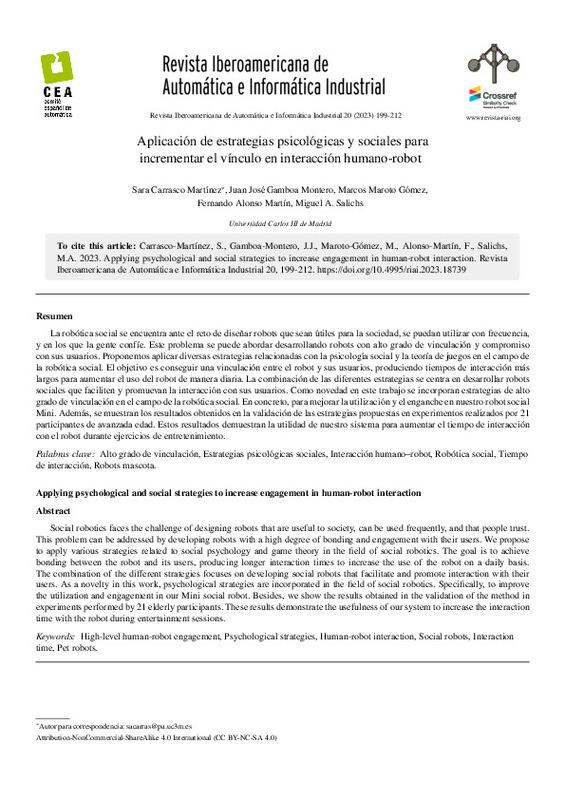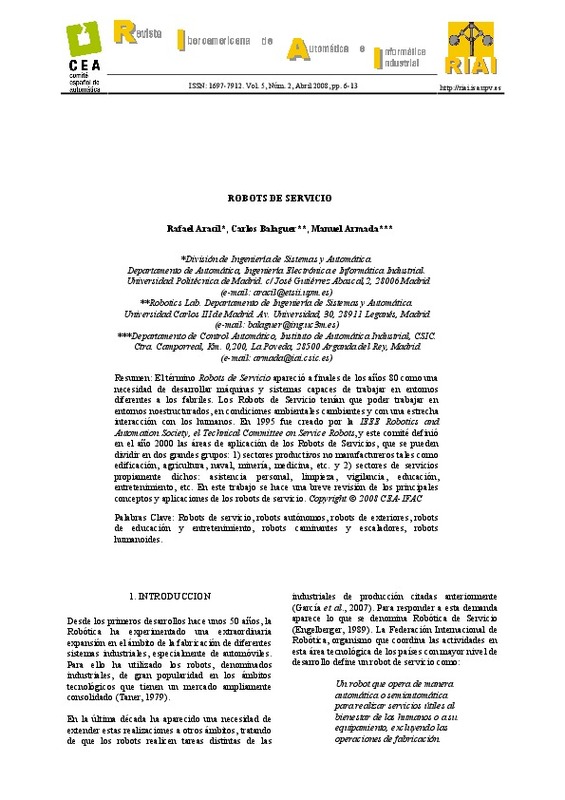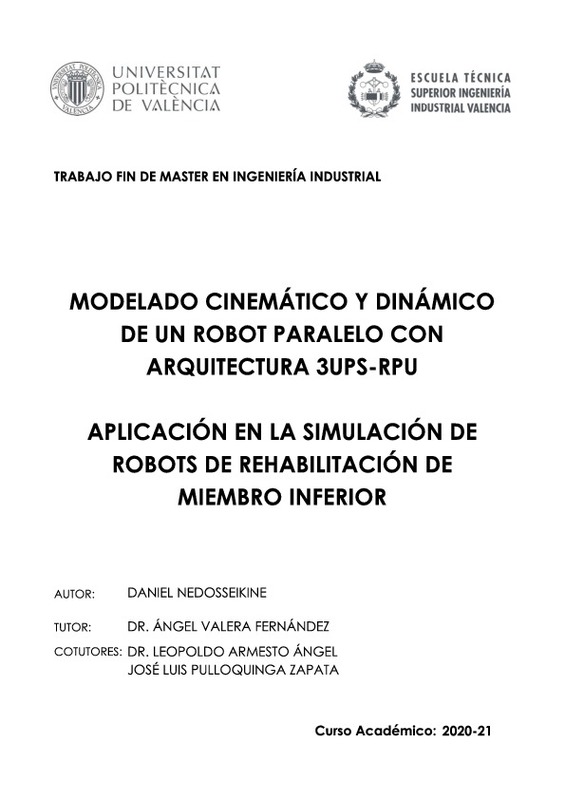JavaScript is disabled for your browser. Some features of this site may not work without it.
Buscar en RiuNet
Listar
Mi cuenta
Estadísticas
Ayuda RiuNet
Admin. UPV
Aplicación de estrategias psicológicas y sociales para incrementar el vínculo en interacción humano-robot
Mostrar el registro sencillo del ítem
Ficheros en el ítem
| dc.contributor.author | Carrasco Martínez, Sara
|
es_ES |
| dc.contributor.author | Gamboa Montero, Juan José
|
es_ES |
| dc.contributor.author | Maroto Gómez, Marcos
|
es_ES |
| dc.contributor.author | Alonso Martín, Fernando
|
es_ES |
| dc.contributor.author | Salichs, Miguel Ángel
|
es_ES |
| dc.date.accessioned | 2023-04-20T07:45:01Z | |
| dc.date.available | 2023-04-20T07:45:01Z | |
| dc.date.issued | 2023-03-31 | |
| dc.identifier.issn | 1697-7912 | |
| dc.identifier.uri | http://hdl.handle.net/10251/192858 | |
| dc.description.abstract | [EN] Social robotics faces the challenge of designing robots that are useful to society, can be used frequently, and that people trust. This problem can be addressed by developing robots with a high degree of bonding and engagement with their users. We propose to apply various strategies related to social psychology and game theory in the field of social robotics. The goal is to achieve bonding between the robot and its users, producing longer interaction times to increase the use of the robot on a daily basis. The combination of the different strategies focuses on developing social robots that facilitate and promote interaction with their users. As a novelty in this work, psychological strategies are incorporated in the field of social robotics. Specifically, to improve the utilization and engagement in our Mini social robot. Besides, we show the results obtained in the validation of the method in experiments performed by 21 elderly participants. These results demonstrate the usefulness of our system to increase the interaction time with the robot during entertainment sessions. | es_ES |
| dc.description.abstract | [ES] La robótica social se encuentra ante el reto de diseñar robots que sean útiles para la sociedad, se puedan utilizar con frecuencia, y en los que la gente confie. Este problema se puede abordar desarrollando robots con alto grado de vinculación y compromiso con sus usuarios. Proponemos aplicar diversas estrategias relacionadas con la psicología social y la teoría de juegos en el campo de la robótica social. El objetivo es conseguir una vinculación entre el robot y sus usuarios, produciendo tiempos de interacción más largos para aumentar el uso del robot de manera diaria. La combinación de las diferentes estrategias se centra en desarrollar robots sociales que faciliten y promuevan la interacción con sus usuarios. Como novedad en este trabajo se incorporan estrategias de alto grado de vinculación en el campo de la robótica social. En concreto, para mejorar la utilización y el enganche en nuestro robot social Mini. Además, se muestran los resultados obtenidos en la validación de las estrategias propuestas en experimentos realizados por 21 participantes de avanzada edad. Estos resultados demuestran la utilidad de nuestro sistema para aumentar el tiempo de interacción con el robot durante ejercicios de entretenimiento. | es_ES |
| dc.description.sponsorship | Esta investigación ha sido apoyada por los siguientes proyectos: Robots Sociales para Estimulación Física, Cognitiva y Afectiva de Mayores (ROSES), RTI2018-096338-B-I00, financiado por el Ministerio de Ciencia, Innovación y Universidades; Robots sociales para mitigar la soledad y el aislamiento en mayores (SOROLI), PID2021-123941OA-I00, financiado por la Agencia Estatal de Investigación (AEI), Ministerio de Ciencia e Innovación de España; el proyecto PLEC2021-007819, financiado por MCIN/AEI/10.13039/501100011033 y por la Union Europea Next- GenerationEU/PRTR, y RoboCity2030-DIH-CM, Madrid Robotics Digital Innovation Hub, S2018/NMT-4331, financiado por “Programas de Actividades I+D en la Comunidad de Madrid” y cofinanciado por los European Social Funds (FSE) de la Unión Europea. | es_ES |
| dc.language | Español | es_ES |
| dc.publisher | Universitat Politècnica de València | es_ES |
| dc.relation.ispartof | Revista Iberoamericana de Automática e Informática industrial | es_ES |
| dc.rights | Reconocimiento - No comercial - Compartir igual (by-nc-sa) | es_ES |
| dc.subject | High-level human-robot engagement | es_ES |
| dc.subject | Psychological strategies | es_ES |
| dc.subject | Human-robot interaction | es_ES |
| dc.subject | Social robots | es_ES |
| dc.subject | Interaction time | es_ES |
| dc.subject | Pet robots | es_ES |
| dc.subject | Alto grado de vinculación | es_ES |
| dc.subject | Estrategias psicológicas sociales | es_ES |
| dc.subject | Interacción humano--robot | es_ES |
| dc.subject | Robótica social | es_ES |
| dc.subject | Tiempo de interacción | es_ES |
| dc.subject | Robots mascota | es_ES |
| dc.title | Aplicación de estrategias psicológicas y sociales para incrementar el vínculo en interacción humano-robot | es_ES |
| dc.title.alternative | Applying psychological and social strategies to increase engagement in human-robot interaction | es_ES |
| dc.type | Artículo | es_ES |
| dc.identifier.doi | 10.4995/riai.2023.18739 | |
| dc.relation.projectID | info:eu-repo/grantAgreement/AEI/Plan Estatal de Investigación Científica y Técnica y de Innovación 2017-2020/RTI2018-096338-B-I00/ES/ROBOTS SOCIALES PARA ESTIMULACION FISICA, COGNITIVA Y AFECTIVA DE MAYORES/ | es_ES |
| dc.relation.projectID | info:eu-repo/grantAgreement/AEI//PID2021-123941OA-I00 | es_ES |
| dc.relation.projectID | info:eu-repo/grantAgreement/AEI//PLEC2021-007819 | es_ES |
| dc.relation.projectID | info:eu-repo/grantAgreement/CM/Madrid Robotics Digital Innovation Hub/S2018/NMT-4331 | es_ES |
| dc.rights.accessRights | Abierto | es_ES |
| dc.description.bibliographicCitation | Carrasco Martínez, S.; Gamboa Montero, JJ.; Maroto Gómez, M.; Alonso Martín, F.; Salichs, MÁ. (2023). Aplicación de estrategias psicológicas y sociales para incrementar el vínculo en interacción humano-robot. Revista Iberoamericana de Automática e Informática industrial. 20(2):199-212. https://doi.org/10.4995/riai.2023.18739 | es_ES |
| dc.description.accrualMethod | OJS | es_ES |
| dc.relation.publisherversion | https://doi.org/10.4995/riai.2023.18739 | es_ES |
| dc.description.upvformatpinicio | 199 | es_ES |
| dc.description.upvformatpfin | 212 | es_ES |
| dc.type.version | info:eu-repo/semantics/publishedVersion | es_ES |
| dc.description.volume | 20 | es_ES |
| dc.description.issue | 2 | es_ES |
| dc.identifier.eissn | 1697-7920 | |
| dc.relation.pasarela | OJS\18739 | es_ES |
| dc.contributor.funder | Agencia Estatal de Investigación | es_ES |
| dc.contributor.funder | Comunidad de Madrid | es_ES |
| dc.contributor.funder | European Commission | es_ES |
| dc.contributor.funder | European Social Fund | es_ES |
| dc.description.references | Barrett, D., 2010. Supernormal stimuli: how primal urges overran their evolutionary purpose. Choice Reviews Online 48 (02), 48-1158. https://doi.org/10.5860/CHOICE.48-1158 | es_ES |
| dc.description.references | Baun, M. M., Bercstrom, N., Lancston, N. F., Thoma, L., 1984. Physiological effects of human/companion animal bonding. Nursing Research 33 (3), 126-129. https://doi.org/10.1097/00006199-198405000-00002 | es_ES |
| dc.description.references | Becoña, E., 2016. La adicción "no" es una enfermedad cerebral. Papeles del Psicólogo 37 (2), 118-125. URL: https://www.redalyc.org/pdf/778/77846055004.pdf | es_ES |
| dc.description.references | Broom, D. M., oct 1991. Animal welfare: concepts and measurement. https://doi.org/10.2527/1991.69104167x | es_ES |
| dc.description.references | Carrasco-Martínez, S., Quispe-Flores, M. A., Sevilla Salcedo, J., Gómez- Jiménez, J., Alonso Martín, F., Salichs, M. A., aug 2021. Comunicación remota entre familiares a través de la robótica social. In: XLII Jornadas de Automática : libro de actas. Servizo de Publicacións da UDC, pp. 565-572. https://doi.org/10.17979/spudc.9788497498043.565 | es_ES |
| dc.description.references | Charles Duhigg, 2015. El poder de los hábitos. Urano. ISBN: 9788415870548. | es_ES |
| dc.description.references | Clear, J., 2018. Atomic Habics. Vol. 1. Random House Business. ISBN: 1847941834. | es_ES |
| dc.description.references | Cobo Hurtado, L., Viñas, P. F., Zalama, E., Gómez-García-Bermejo, J., Delgado, J. M., Vielba García, B., 2021. Development and usability validation of a social robot platform for physical and cognitive stimulation in elder care facilities. In: Healthcare. Vol. 9. p. 1067. https://doi.org/10.3390/healthcare9081067 | es_ES |
| dc.description.references | Costa, M., Corazza, L., jun 2006. Aesthetic phenomena as supernormal stimuli: The case of eye, lip, and lower-face size and roundness in artistic portraits. Perception 35 (2), 229-246. https://doi.org/10.1068/p3449 | es_ES |
| dc.description.references | D.Volkow, N., 2004. Las drogas, el cerebro y el comportamiento: la ciencia de la adicción. National Institute on Drug Abuse. URL: https://cutt.ly/WN5azU2 | es_ES |
| dc.description.references | Eyal, N., Hoover, R., 2014. HOOKED: How to Build Habit-Forming Products. Sunshine Business Dev. ISBN:0241184835. | es_ES |
| dc.description.references | Ezatollah Ghadampour, Fazlollah Mirderikvand, K. B., 2017. The Effectivness of Logothrapy Training on Academic Engagement in Student. Advances in Cognitive Science 19 (2), 52-62. URL: http://icssjournal.ir/article-1-538-en.htmlhttp://icssjournal.ir/browse.php?a_code=A-10-2-517&slc_lang=en&sid=1 | es_ES |
| dc.description.references | Frankl, V. E., 2014. The will to meaning - Foundations and applications of logotherapy, new york n Edition. Vol. 2/7. Plume. URL: https://www.scirp.org/(S(lz5mqp453edsnp55rrgjct55))/reference/referencespapers.aspx?referenceid=2555574 | es_ES |
| dc.description.references | Garrity, T. F., Stallones, L. F., Marx, M. B., Johnson, T. P., mar 1989. Pet Ownership and Attachment as Supportive Factors in the Health of the Elderly. Anthrozoos 3 (1), 35-44. https://doi.org/10.2752/089279390787057829 | es_ES |
| dc.description.references | Gómez, L. F., Atehortua, C. G., Orozco, S. C., 2007. La influencia de las mascotas en la vida humana. Revista Colombiana de Ciencias Pecuarias 20 (3), 377-386. | es_ES |
| dc.description.references | Griffths, M. D., 2010. The hidden addiction: Gambling in the workplace. Counselling at Work, 20-23. URL: https://www.bacp.co.uk/bacp-journals/bacp-workplace/autumn-2010/the-hidden-addiction/http://irep.ntu.ac.uk/id/eprint/8152/1/205698_7854GriffithsPublisher.pdf | es_ES |
| dc.description.references | Homme, L. E., DeBaca, P. C., Devine, J. V., Steinhorst, R., Rickert, E. J., oct 1963. Use of the Premack principle in controlling behavior of nursery school children. Journal of the Experimental Analysis of Behavior 6 (4), 544. https://doi.org/10.1901/jeab.1963.6-544 | es_ES |
| dc.description.references | Kim, S. K., Kim, S. Y., Kang, H. B., 2016. An Analysis of the Effects of Smartphone Push Notifications on Task Performance with regard to Smartphone Overuse Using ERP. Computational Intelligence and Neuroscience 2016. https://doi.org/10.1155/2016/5718580 | es_ES |
| dc.description.references | Knapp, T. J., jan 1976. The Premack principle in human experimental and applied settings. Behaviour Research and Therapy 14 (2), 133-147. https://doi.org/10.1016/0005-7967(76)90067-X | es_ES |
| dc.description.references | Lane, M., jun 2015. Worth the risk? Modeling irrational gambling behavior. Mathematics Enthusiast 12 (1-3), 31-37. https://doi.org/10.54870/1551-3440.1332 | es_ES |
| dc.description.references | Lemieux, C., McDonald, D., 2020. Frictionless : why the future of everything will be fast, fluid & made just for you. Harper Business. ISBN:9780062893680. | es_ES |
| dc.description.references | Maroto-Gómez, M., Castro-González, A., Castillo, J. C., Malfaz, M., Salichs, M. A., 2022. An adaptive decision-making system supported on user preference predictions for human-robot interactive communication. User Modeling and User-Adapted Interaction, 1-45. https://doi.org/10.1007/s11257-022-09321-2 | es_ES |
| dc.description.references | Morris, P. H., White, J., Morrison, E. R., Fisher, K., may 2013. High heels as supernormal stimuli: How wearing high heels a ects judgements of female attractiveness. Evolution and Human Behavior 34 (3), 176-181. https://doi.org/10.1016/j.evolhumbehav.2012.11.006 | es_ES |
| dc.description.references | Nasti, L., Michienzi, A., Guidi, B., 2021. Discovering the Impact of Notifications on Social Network Addiction. In: Lecture Notes in Computer Science (including subseries Lecture Notes in Artificial Intelligence and Lecture Notes in Bioinformatics). Vol. 12611 LNCS. Springer Science and Business Media Deutschland GmbH, pp. 72-86. https://doi.org/10.1007/978-3-030-70650-0 | es_ES |
| dc.description.references | Peper, E., Harvey, R., Cannon, R. L., Lyle, R., mar 2018. Digital Addiction: Increased Loneliness, Anxiety, and Depression. NeuroRegulation 5 (1), 3-3. https://doi.org/10.15540/nr.5.1.3 | es_ES |
| dc.description.references | Ronderos, N., 2000. Tamagotchi, la mascota virtual: la globalización y la sociedad de la simulación a través de una tecnología del ocio. Antropologías transeúntes. | es_ES |
| dc.description.references | Ruckauer, F. J. C., 2016. Introducción al diseño de videojuegos: Enganche y retención. URL: https://en.calameo.com/read/005101872b8d9e41eba1d | es_ES |
| dc.description.references | Salichs, M. A., Castro-González, A., Salichs, E., Fernández-Rodicio, E., Maroto-Gómez, M., Gamboa-Montero, J. J., Marques-Villarroya, S., Castillo, J. C., Alonso-Martín, F., Malfaz, M., dec 2020. Mini: A New Social Robot for the Elderly. International Journal of Social Robotics 12 (6), 1231-1249. https://doi.org/10.1007/s12369-020-00687-0 | es_ES |
| dc.description.references | Sapolsky, R. M., 2017. Behave: The Biology of Humans at Our Best andWorst. Penguin Press. | es_ES |
| dc.description.references | Shibata, T., Kawaguchi, Y., Wada, K., Shibata, T., Kawaguchi, Y., Wada, . K., Wada, K., sep 2011. Investigation on People Living with Seal Robot at Home. International Journal of Social Robotics 2011 4:1 4 (1), 53-63. https://doi.org/10.1007/s12369-011-0111-1 | es_ES |
| dc.description.references | Skinner, B., 1965. Science And Human Behavior. The Free Press. ISBN:0029290406. | es_ES |
| dc.description.references | Skinner, B., Ardilla, R., 1975. Sobre el Conductismo, fontanella Edition. Fontanella. | es_ES |
| dc.description.references | Tamura, T., Yonemitsu, S., Itoh, A., Oikawa, D., Kawakami, A., Higashi, Y., Fujimooto, T., Nakajima, K., 2004. Is an entertainment robot useful in the care of elderly people with severe dementia? The Journals of Gerontology Series A: Biological Sciences and Medical Sciences 59 (1), M83-M85. https://doi.org/10.1093/gerona/59.1.M83 | es_ES |
| dc.description.references | Volkow, N. D., Wang, G. J., Fowler, J. S., Tomasi, D., Telang, F., sep 2011. Addiction: Beyond dopamine reward circuitry. https://doi.org/10.1073/pnas.1010654108 | es_ES |
| dc.description.references | Zack, M., St. George, R., Clark, L., apr 2020. Dopaminergic signaling of uncertainty and the aetiology of gambling addiction. https://doi.org/10.1016/j.pnpbp.2019.109853 | es_ES |











